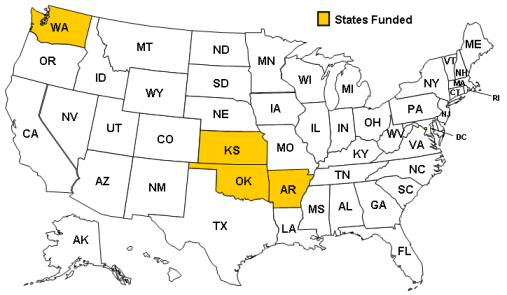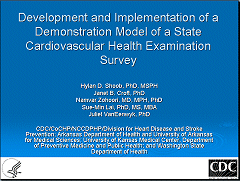State Cardiovascular Health Examination Survey
In 2005, the CDC Division for Heart Disease and Stroke Prevention funded three states (Arkansas, Kansas, and Washington) for the development and implementation of a state cardiovascular health examination survey to inform and provide guidance to the states in the development of hypertension and cholesterol control strategies. The project was to address the "Healthy People 2010" focus area related to heart disease and stroke. With the exception of a few states, data had not been collected at the state level that would allow the states to monitor progress towards addressing the objectives related to improving the control of high blood pressure and high cholesterol. The purpose of this project is to enhance the scientific capacity of a state program by implementing a state cardiovascular health examination survey to collect data on levels of blood pressure and blood cholesterol and other relevant information and to provide information for priority populations to guide the state in the development, implementation, and evaluation of cardiovascular health promotion and risk factor control strategies to eliminate health disparities. The pilot project (2005–2007) was a supplement to the state program Funding Opportunity Announcement (FOA). The State Cardiovascular Health Examination Survey is now a stand alone FOA. The newest state to participate is Oklahoma (2007–2009). A prerequisite for obtaining state cardiovascular health examination survey funding is to receive state program funding from CDC's Division for Heart Disease and Stroke Prevention.

Until this demonstration project was funded, data had not been collected at the state level to allow the state to monitor progress towards addressing these objectives which call for actual risk factor measurements. This project will allow for the development of a demonstration model to enhance the scientific capacity of a state program by implementing a state cardiovascular health examination survey; collecting data on levels of blood pressure, blood cholesterol, and other relevant information; comparing data between priority populations and the general public; and providing guidance to states in developing, implementing, and evaluating cardiovascular health promotion and risk factor control strategies to reduce the burden of death, disabilities, cost, and eliminate health disparities.
Information collected will include, but not be limited to measurement of lipid and lipoprotein cholesterol blood levels; blood pressure levels; anthropometric levels; information on other relevant risk factors or behaviors; history of heart diseases, stroke, and diabetes; medications prescribed and actions taken to control high blood pressure and high cholesterol; and demographic and socioeconomic information. Data will not be transmitted to CDC. CDC does not expect or encourage the grantees to combine data from the four states because each state has its own unique data collection strategy.
This project addresses the following Healthy People 2010 objectives related to heart disease and stroke. (Source: http://www.healthypeople.gov/Document/HTML/Volume1/12Heart.htm).
- 12–9: Reduce the proportion of adults with high blood pressure.
- 12–10: Increase the proportion of adults with high blood pressure whose blood pressure is under control.
- 12–11: Increase the proportion of adults with high blood pressure who are taking action (for example, losing weight, increasing physical activity, or reducing sodium intake) to help control their blood pressure.
- 12–13: Reduce the mean total blood cholesterol levels among adults.
- 12–14: Reduce the proportion of adults with high total blood cholesterol levels.
- 12–16: Increase the proportion of persons with coronary heart disease who have their low density lipoprotein cholesterol level treated to a goal of less than or equal to 100 mg/dL.
Arkansas
This project will implement the Arkansas Cardiovascular Health Examination Survey (ARCHES). ARCHES will collect data on levels of blood pressure and blood cholesterol and other relevant information, allow comparisons between blacks and the general public, and provide guidance to the state in developing, implementing, and evaluating cardiovascular health promotion and risk factor control strategies to eliminate health disparities. Arkansas has the highest stroke mortality rate in the nation, and the 15th highest heart disease mortality rate.
Variables
ARCHES Questionnaire Domains
- Introduction and verification
- Screener (via initial phone contact)
- Consent form (including for blood sample)
- Sociodemographics: age, gender, ethnicity/race, education, income, marital status, employment/occupation, HH composition (# adults/# children), housing
- Tracking and tracing information
- Self–rated health
- Weight history (including self reported weight and height)
- Health insurance
- Hospitalization and access to care
- Smoking and tobacco use
- Drinking
- Blood pressure knowledge/history
- Cholesterol knowledge/history
- Cardiovascular disease knowledge/history
- Diabetes knowledge/history
- Kidney disease knowledge/history
- Oral/dental health
- Sleep patterns
- Depression/stress
- Dietary supplements and prescription medication
- Diet behavior and nutrition
- Physical activity
- Physical functioning (disabilities; ADL/IADL)
- Selective medical conditions history
- Family health history
- Food security
- Social support
- Reactions to race
Examinations Variables
- Height and weight
- Waist circumference
- Blood pressure
- Blood tests:
- Lipid profile (including total cholesterol, LDL, HDL)
- Fasting glucose
- Creatinine
- High sensitivity C Reactive Protein
- Homocysteine
- Cystatin–C
- Serum creatinine
- Fasting serum insulin (on known diabetics only)
- HbA1c (on kown diabetics only)
- Calcium
- Parathyroid Hormone (PTH)
- Phosphate
- Hemoglobin
- Cotinine
- Urinary albumin to creatinine ratio (ACR)
Kansas
The goal of this project is to design a model to implement a statewide survey and clinical assessment of cardiovascular health risk profiles. This study will allow the state of Kansas to gain a better insight as to the burden of cardiovascular disease (CVD) risk factors in Kansans and the level of control of those risk factors in various racial/ethnic populations in Kansas. This project will further empower local health departments to respond to the state health department for various health related initiatives. In Kansas, CVD is the leading cause of death.
Variables
- Blood variables:
- Total cholesterol
- LDL/HDL
- Triglycerides
- Blood sugar
- HbA1c
Smoking Variables
- Smoked at least 100 cigarettes in the entire life
- Cigarette smoking frequency
- Age when the respondent last smoked cigarettes
- How long has it been since the respondent quit smoking cigarettes?
- Anyone who lives in the respondent's house smoke cigarettes, cigars, or pipes anywhere inside the participant's home
Medical History Variables
- MI
- Angina/CHD
- Stroke
- TIA
- Atrial fibrillation
- Deep venous thrombosis
- Pulmonary embolus
- Peripheral arterial disease
- Left ventricular heart hypertrophy
- Other heart disease
- Hospitalization on selected heart conditions.
- Symptoms of angina
- Symptoms of congestive heart failure
- Symptoms of peripheral arterial disease
- Knowledge on heart attack and stroke symptoms
- Personal history of blood pressure
- Personal history of cholesterol
- Personal history of diabetes
- When the respondent was told having the condition and what actions were taken to alleviate the condition will be ascertained.
- Personal history of aspirin use
- Personal history of oral health
- Personal history of weight and height
- Family history of blood pressure
- Family history of heart attack
- Family history of high cholesterol
- Family history of diabetes
- Female participants—hormonal replacement use
- Physical activity
- Apnea
- Diet and nutrition
- Social support
Oklahoma
Oklahoma has the second highest cardiovascular disease mortality rate in the United States. The Oklahoma Cardiovascular Health Examination Survey (OKCHES) will provide information to assist Oklahoma in reducing the prevalence of cardiovascular disease in the population, and address the disparity in disease prevalence among Whites, Blacks, and American Indians in Oklahoma.
Oklahoma Cardiovascular Health Examination Survey, 2007–2009
The Oklahoma Heart Disease and Stroke Prevention Program is developing and implementing the OKCHES to collect data from a sample representative of the State’s population. The priority populations are American Indians and Blacks. The OKCHES will consist of three components: phone interviews, physical measurements (including laboratory measurements), and a food frequency questionnaire. The participant’s answers to the Oklahoma BRFSS will be linked to their OKCHES answers and results.
Questionnaires
- Actions to control high blood pressure
- History of cholesterol checked
- Actions to control high cholesterol
- History of CHD/angina
- History of stroke
- History of other cardiovascular diseases
- History of diabetes
- History of aspirin use
- Rehab following heart attack/stroke
- Physical activity
- Doctor advice about weight
- Family health history
- Tribal affiliation and enrollment
- Degree of Indian blood
- Tribal/IHS/urban Indian health center use
- Dietary intake and nutrition (Food Frequency Questionnaire)
- 2008-2009 Oklahoma BRFSS questions
Examination
- Height
- Weight
- Waist circumference
- Blood pressure
- Fasting laboratory measurements: Lipid panel, Direct LDL, Glucose, C-reactive protein
Washington
The State will collect population-based data on blood pressure, lipids, and lipoproteins. The information will be used to estimate prevalence of high blood pressure and high cholesterol, measure progress in meeting Healthy People 2010 objectives, and guide the state in developing interventions to prevent heart disease and stroke. Lab assays will be conducted by the Northwest Lipid Metabolism and Diabetes Research Laboratories, a partner in the CDC/NHLBI Lipid Standardization Program.
Data will be collected to represent the state population as well as a priority group, adults 25 years and older with annual household incomes less than $25,000. Survey questions, measures, and protocols will be based on those of the Behavioral Risk Factor Surveillance System and the National Health and Nutrition Examination Survey.
Variables
- Biological samples: HDL, LDL, VLDL, triglycerides, glucose
- Anthropometric measures: height, weight, waist circumference, blood pressure, pulse, arcus senilis
- Interview data
- Self-administered questionnaire: smoking and tobacco questions; stress module; Physical activity questions
- Food frequency questionnaire
- Mercury component
- Hair sample
- Occupation questions
Related Information
State Heart Disease and Stroke Prevention Program
CDC funds health departments in 32 states and the District of Columbia to develop effective strategies to reduce the burden of heart disease and stroke and their risk factors. The program stresses the need for policy and systems changes that promote heart–healthy and stroke–free living and working conditions.
Healthy People 2010
The federal government's prevention agenda for building a healthier nation. There are 16 health objectives specific to heart disease and stroke, and more in areas that relate to heart disease and stroke. CDC is a co–lead agency with the National Heart, Lung, and Blood Institute for the heart disease and stroke focus area.
Presentations
Development and Implementation of a Demonstration Model of a State Cardiovascular Health Examination Survey
| View Full Document Online [PDF–542K] Download: [PPT–376K] (Save file to your computer in order to view speaker notes) |
- Page last reviewed: August 1, 2013
- Page last updated: August 1, 2013
- Content source:



 ShareCompartir
ShareCompartir
